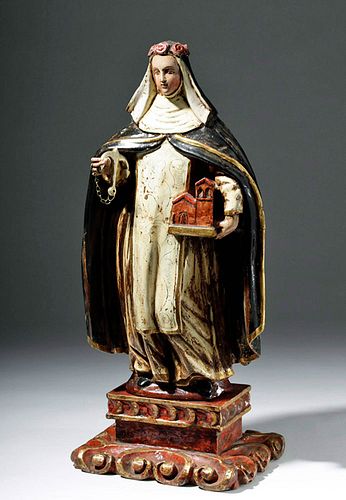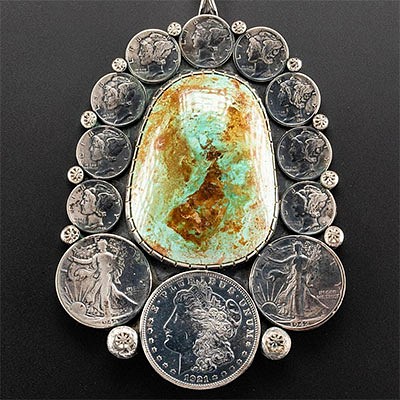18th C. Spanish Colonial Santo Rose of Lima 26"H
Lot 54a
About Seller
Artemis Gallery
686 S Taylor Ave, Ste 106
Louisville, CO 80027
United States
Selling antiquities, ancient and ethnographic art online since 1993, Artemis Gallery specializes in Classical Antiquities (Egyptian, Greek, Roman, Near Eastern), Asian, Pre-Columbian, African / Tribal / Oceanographic art. Our extensive inventory includes pottery, stone, metal, wood, glass and textil...Read more
Estimate:
$4,000 - $6,000
Absentee vs Live bid
Two ways to bid:
- Leave a max absentee bid and the platform will bid on your behalf up to your maximum bid during the live auction.
- Bid live during the auction and your bids will be submitted real-time to the auctioneer.
Bid Increments
| Price | Bid Increment |
|---|---|
| $0 | $25 |
| $300 | $50 |
| $1,000 | $100 |
| $2,000 | $250 |
| $5,000 | $500 |
| $10,000 | $1,000 |
| $20,000 | $2,500 |
| $50,000 | $5,000 |
| $100,000 | $10,000 |
| $200,000 | $20,000 |
About Auction
By Artemis Gallery
Feb 25, 2021
Set Reminder
2021-02-25 10:00:00
2021-02-25 10:00:00
America/New_York
Bidsquare
Bidsquare : American Frontier | Ethnographic | Tribal Art
https://www.bidsquare.com/auctions/artemis-gallery/american-frontier-ethnographic-tribal-art-6449
Featuring historical examples from the American, Spanish, and Mexican frontiers, as well as Native American, Ethnographic, Tribal, Oceanic, Spanish Colonial, more. All items offered for sale have been legally acquired, are legal to sell and are guaranteed to be as described or your money back. Artemis Gallery info@artemisgallery.com
Featuring historical examples from the American, Spanish, and Mexican frontiers, as well as Native American, Ethnographic, Tribal, Oceanic, Spanish Colonial, more. All items offered for sale have been legally acquired, are legal to sell and are guaranteed to be as described or your money back. Artemis Gallery info@artemisgallery.com
- Lot Description
New World, Mexico, ca. 18th century CE. Grand in scale, a skillfully carved and finely painted wood santo of Rose of Lima, the primary patroness of Peru who holds the distinction of being the first in the New World to be canonized. She is usually depicted wearing a Dominican habit and a crown of thorns or roses as we see here. She carries one of her chief attributes, and anchor, as well as a house as she provided shelter, stability, and care for the needy throughout her life. Size: 8.5" L x 10.25" W x 23" H (21.6 cm x 26 cm x 58.4 cm)
Born Isabel Flores de Oliva in Lima in 1568, Rose of Lima lived her 31 years in voluntary penance and prayer, caring for the needy and living a life of extreme asceticism. Her nickname "Rose" arose from an incident when she was a baby - a servant claimed to see her face transform into a beautiful rose. She was confirmed by the Archbishop of Lima in 1597; this same Archbishop Tiribio de Mogrovejo later declared her a saint, and it was at this time that she formally took the name Rose. As a young girl she was admired for her beauty, but cut off her hair and smeared her face with pepper so that potential suitors would lose interest as she was more interested in tending to the needy. In emulation of St. Catherine of Siena, she took to daily fasting, and helped the hungry and the sick in her community by bringing them to her room (the house she holds may be a reference to this shelter) to take care of them. To care for the poor, Rose made and sold lace and embroidery. Rose also sold her needlework and flowers that she grew to help her family. For these reasons, Rose of Lima is the patron saint of embroiderers, gardeners, and florists.
Santos played an important role in bringing the Catholic Church to the New World with the Spanish colonists. These religious figures were hand-carved and often furnished with crowns, jewels, and other accessories, usually funded by religious devotees, and were used as icons to explain the major figures - Mary, Christ, and the saints - to new, indigenous converts. Likewise, they served as a connection to the Old World for Spanish colonists far from home. Many of them were lovingly cared for over the years, with repairs and paint added as they aged, and played an active part for a long time in the religious life of their communities. Oftentimes regarded as quite valuable and expensive, the creation of Santos was usually funded by religious devotees.
Provenance: private Francis & Lilly Robicsek Collection, Charlotte, North Carolina, USA, acquired second half of the 20th century
All items legal to buy/sell under U.S. Statute covering cultural patrimony Code 2600, CHAPTER 14, and are guaranteed to be as described or your money back.
A Certificate of Authenticity will accompany all winning bids.
We ship worldwide and handle all shipping in-house for your convenience.
#120449Surface wear with minor losses to pigment and gold leaf. Minor losses to peripheries of base. Stable crack to robes beneath the house St. Rose holds. Hole atop her head suggests there was once another attachment.Condition
- Shipping Info
-
All shipping is handled in-house for your convenience. Your invoice from Artemis Gallery will include shipping calculation instructions. If in doubt, please inquire BEFORE bidding for estimated shipping costs for individual items.
-
- Buyer's Premium



 EUR
EUR CAD
CAD AUD
AUD GBP
GBP MXN
MXN HKD
HKD CNY
CNY MYR
MYR SEK
SEK SGD
SGD CHF
CHF THB
THB


















